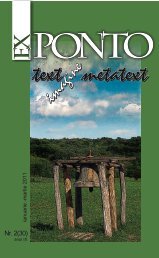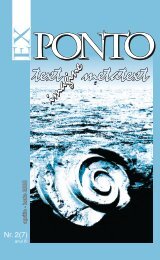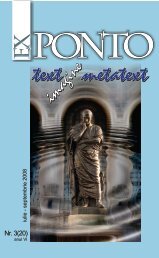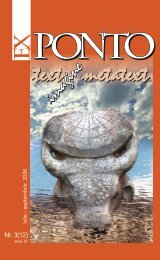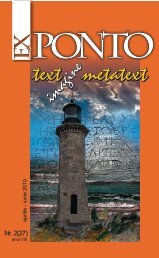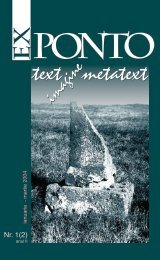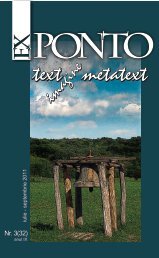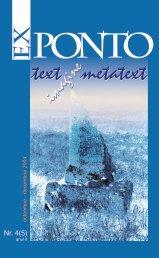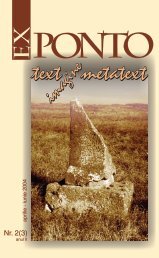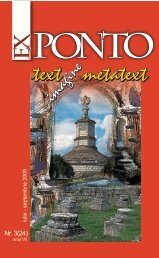Nr. 4 (21) anul VI / octombrie-decembrie 2008 - ROMDIDAC
Nr. 4 (21) anul VI / octombrie-decembrie 2008 - ROMDIDAC
Nr. 4 (21) anul VI / octombrie-decembrie 2008 - ROMDIDAC
You also want an ePaper? Increase the reach of your titles
YUMPU automatically turns print PDFs into web optimized ePapers that Google loves.
EX PONTO NR.4, <strong>2008</strong><br />
112<br />
women are dressed in the traditional costume, offering a visually detailed<br />
support to the ekphrasis:<br />
The women wear a high-necked, ankle-long chemise of white<br />
homespun linen, with full sleeves gathered at the elbow and richly<br />
embroidered, usually with blue. Bands of narrow embroidery decorate<br />
the waist and the skirt also. The chemise is girded to the body by a thick<br />
woolen belt, binding tightly to the figure the upper edge of a narrow apron<br />
of striped swollen homespun, very brilliant in color. ∂…∑ This dress is<br />
preserved with jealous care, and is never produced except on Sundays<br />
and holidays. 4<br />
The images became more and more popular in the newspapers around<br />
the 1890s and the American newspapers used illustrations to arrest their<br />
readers’ eyes and interest. “The photograph provided a model for the<br />
desired journalistic impact: objective, true to life, mesmerizing” state Stuart<br />
and Elizabeth Ewen in their book Channels of Desire. Mass Images and<br />
the Shaping of American Consciousness. Analyzing the contribution of the<br />
illustrated journalism to the formation of the American multi-ethnic society,<br />
they reached the conclusion that “the camera was a powerful mechanism<br />
for conveying fantasy and suggesting transcendence; its imagery employed<br />
a powerful, visual vernacular, understandable even to immigrants unable<br />
to speak English” (18). In this context, the publication of the Romanian<br />
monarch’s photos and of the illustrations depicting Romanian soldiers helped<br />
Americans identify Romanians as people with ancient roots reflected by their<br />
hand-made outfits, in the process of modernization, and eager to fight for their<br />
independence and national unity.<br />
The image of the Romanian folk costume continued to be internationally<br />
promoted for the first two decades of the twentieth century due to the following<br />
Romanian queens who perpetuated Queen Elizabeth’s model and wore<br />
national costumes at official dinners, other public events, and in postcards.<br />
The favorite of the American magazines was Queen Mary. Her devotion to the<br />
wounded soldiers during the First World War and her cultural activism were<br />
constantly subjects of the European and American journalist alike. Articles<br />
about her work as a nurse in the war hospitals or about her writings were<br />
published in: The Graphic (1893, 1918), The Ladies’ Home Journal (1916),<br />
The Century Magazine (1918), National Geographic (1922, 23), Vanity Fair<br />
(1932), The Saturday Evening Post (1933), etc. Moreover, her meeting with<br />
the US president Woodrow Wilson in Paris on April 11, 1919 at the Peace<br />
Conference was covered by the American journals as well as her 1926 tour<br />
in the US, which was considered one of the featured events of the year.<br />
Romanian Folk Culture at World’s Fairs<br />
Simultaneously, the world’s fairs exhibited Romanian products, artworks,<br />
and more importantly, they brought folk bands to sing, play, and dance to<br />
Romanian folk music. Romania had participated uninterruptedly at the world’s<br />
fairs since 1867, when it was invited at the Parisian Exhibition until the 1939<br />
New York World’s Fair. For more than five decades, Romania represented<br />
herself as a rural country, whose peasants preserved the authentic Roman<br />
heritage and its essential national traits. 5 The myth of the bon sauvage offered<br />
a framework for understanding the rural societies and their life. Explanatory<br />
texts which accompanied the exhibition contained significant information.<br />
Statistics mentioned that four fifths of the population lived in rural areas




